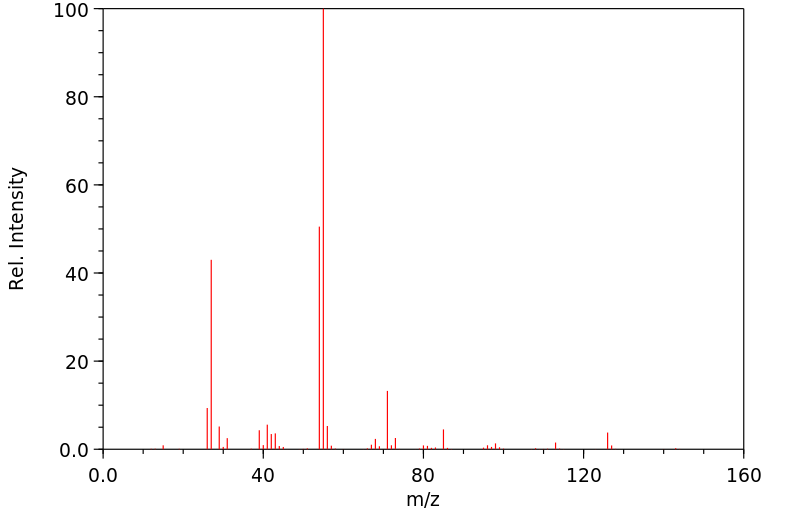1,4-丁二醇二丙烯酸酯 | 1070-70-8
中文名称
1,4-丁二醇二丙烯酸酯
中文别名
1,4-双(丙烯酰氧基)丁烷;四亚甲基乙二醇二丙烯酸酯;二丙烯酸-1,4-丁二酯;BDDA
英文名称
1,4-Butanediol diacrylate
英文别名
butane-1,4-diyl diacrylate;4-prop-2-enoyloxybutyl prop-2-enoate
CAS
1070-70-8;31442-13-4
化学式
C10H14O4
mdl
MFCD00014940
分子量
198.219
InChiKey
JHWGFJBTMHEZME-UHFFFAOYSA-N
BEILSTEIN
——
EINECS
——
-
物化性质
-
计算性质
-
ADMET
-
安全信息
-
SDS
-
制备方法与用途
-
上下游信息
-
文献信息
-
表征谱图
-
同类化合物
-
相关功能分类
-
相关结构分类
物化性质
-
熔点:-7°C
-
沸点:83 °C/0.3 mmHg (lit.)
-
密度:1.051 g/mL at 25 °C (lit.)
-
闪点:>230 °F
-
溶解度:16.3克/升
-
LogP:1.9 at 23℃
-
物理描述:Liquid
计算性质
-
辛醇/水分配系数(LogP):1.9
-
重原子数:14
-
可旋转键数:9
-
环数:0.0
-
sp3杂化的碳原子比例:0.4
-
拓扑面积:52.6
-
氢给体数:0
-
氢受体数:4
安全信息
-
TSCA:Yes
-
危险等级:8
-
危险品标志:C
-
安全说明:S26,S36/37/39,S45
-
危险类别码:R34,R21,R43
-
WGK Germany:1
-
海关编码:2916190090
-
危险品运输编号:UN 1760 8/PG 2
-
RTECS号:UD3130000
-
包装等级:II
-
危险类别:8
-
危险标志:GHS05,GHS07
-
危险性描述:H312,H314,H317
-
危险性防范说明:P280,P303 + P361 + P353,P304 + P340 + P310,P305 + P351 + P338,P333 + P313
SDS
上下游信息
-
上游原料
中文名称 英文名称 CAS号 化学式 分子量 —— 1,4-di(β-bromopropionylhydroxy)butane 16658-76-7 C10H16Br2O4 360.043 -
下游产品
中文名称 英文名称 CAS号 化学式 分子量 1H-吲唑,6-溴-4-氯- 4-hydroxybutyl acrylate 2478-10-6 C7H12O3 144.17
反应信息
-
作为反应物:描述:1,4-丁二醇二丙烯酸酯 在 phosphate buffer 、 carboxylesterase from Brevibacterium linens IFO 12171 作用下, 以 水 为溶剂, 生成 1H-吲唑,6-溴-4-氯-参考文献:名称:A New Carboxylesterase fromBrevibacterium linensIFO 12171 Responsible for the Conversion of 1,4-Butanediol Diacrylate to 4-Hydroxybutyl Acrylate: Purification, Characterization, Gene Cloning, and Gene Expression inEscherichia coli摘要:在 Brevibacterium 菌系 IFO 12171 中发现了一种负责将 1,4 丁二醇二丙烯酸酯(BDA)转化为 4-hydroxybutyl acrylate(4HBA)的羧基酯酶,并将其纯化至均一。纯化的酶对乙二醇、1,4-丁二醇和 1,6-己二醇的各种二酯具有活性。该酶对 BDA 的 Km 和 kcat 分别为 3.04 mM 和 203,000 s-1。用纯化的酶反应 60 分钟,100 mM BDA 可产生 98 mM 4HBA。编码该酶的开放阅读框长 1176 bp,对应于 393 个氨基酸残基的蛋白质(分子质量=42,569 Da)。推导出的氨基酸序列包含四肽基序 STTK,通过定点突变几个氨基酸残基,证实丝氨酸残基是 BDA 酯酶的催化中心。该基因在 lac 启动子的控制下在大肠杆菌中表达,基因产物(与 β-半乳糖苷酶的 6 个氨基酸残基的融合蛋白)显示出与亲本菌株的酶相同的催化特性。DOI:10.1271/bbb.63.688
-
作为产物:描述:参考文献:名称:抗肿瘤药。8.O,O′-双(丙烯酰基)-α,ω-链烷二醇的合成和细胞毒性活性。摘要:DOI:10.1002/jps.2600630734
文献信息
-
Process for the conversion of aldehydes to esters申请人:Saudi Basic Industries Corporation (SABIC)公开号:US20030216587A1公开(公告)日:2003-11-20A process for the conversion of aldehydes to esters, specifically acrolein or methacrolein to methyl acrylate or methyl methacrylate, respectively. Essentially in the absence of water, an aldehyde is contacted with an oxidizing agent to form an intermediate and then the intermediate is contacted with a diol or an alcohol to form an ester or diester. Preferably, the oxidizing agent is also a chlorinating agent. Specifically, acrolein or methacrolein is contacted with an oxidizing/chlorinating agent, such as t-butyl hypochlorite, and the chlorinated compound is contacted with an alcohol, such as methanol, to form methyl acrylate or methyl methacrylate, respectively. Generally, the order of addition is for the oxidizing agent to be added to the aldehyde, specifically for t-butyl hypochlorite to be added to acrolein or methacrolein, and for the diol or alcohol to be added to the intermediate, specifically for the methanol to be added to the reaction product of acrolein or methacrolein and t-butyl hypochlorite. The process of the present invention can be carried out in the absence or in the presence of solvent. Generally, better methyl acrylate or methyl methacrylate yields are obtained at lower reaction temperatures.将醛类化合物转化为酯类化合物的方法,具体是将丙烯醛或甲基丙烯醛分别转化为丙烯酸甲酯或甲基丙烯酸甲酯。基本上在无水的情况下,将醛类化合物与氧化剂接触以形成中间体,然后将中间体与二元醇或醇类化合物接触以形成酯类或二酯类化合物。最好,氧化剂也是氯化剂。具体地,将丙烯醛或甲基丙烯醛与氧化/氯化剂接触,例如叔丁基次氯酸酯,然后将氯化化合物与醇类接触,例如甲醇,分别形成丙烯酸甲酯或甲基丙烯酸甲酯。一般来说,添加顺序是将氧化剂加入到醛类化合物中,具体来说是将叔丁基次氯酸酯加入到丙烯醛或甲基丙烯醛中,然后将二元醇或醇类加入到中间体中,具体来说是将甲醇加入到丙烯醛或甲基丙烯醛与叔丁基次氯酸酯反应生成的产物中。本发明的方法可以在无溶剂或有溶剂的情况下进行。一般来说,在较低的反应温度下可以获得更好的丙烯酸甲酯或甲基丙烯酸甲酯产率。
-
Iodine-mediated one-pot synthesis of C-3 acylated indolizines from pyridines, aryl methyl ketones and acrylate derivatives作者:Youlai Fang、Lisheng He、Weidong Pan、Yuzhu YangDOI:10.1016/j.tet.2019.05.058日期:2019.7reaction from pyridines, aryl methyl ketones and electron deficient acrylates has been accomplished in a “one-pot” manner, which provides a straightforward and efficient access to C-3 acylated indolizines. The key intermediate of N-ylides is hypothesized to be generated in situ from pyridines and (hetero)aryl methyl ketones in the presence of iodine. This method has been applied in the synthesis of two
-
A Facile Approach to Bis(isoxazoles), Promising Ligands of the AMPA Receptor作者:Dmitry A. Vasilenko、Kirill S. Sadovnikov、Kseniya N. Sedenkova、Dmitry S. Karlov、Eugene V. Radchenko、Yuri K. Grishin、Victor B. Rybakov、Tamara S. Kuznetsova、Vladimir L. Zamoyski、Vladimir V. Grigoriev、Vladimir A. Palyulin、Elena B. AverinaDOI:10.3390/molecules26216411日期:——convenient synthetic approach to novel functionalized bis(isoxazoles), the promising bivalent ligands of the AMPA receptor, was elaborated. It was based on the heterocyclization reactions of readily available electrophilic alkenes with the tetranitromethane-triethylamine complex. The structural diversity of the synthesized compounds was demonstrated. In the electrophysiological experiments using the patch
-
多価エステル化合物およびその製造方法申请人:株式会社日本触媒公开号:JP2017128510A公开(公告)日:2017-07-27【課題】アクリル樹脂とも高い親和性を有し、アクリル樹脂フィルムに使用した場合に耐折り曲げ性の改善が可能であり、取り扱い性に優れ、ブリードアウトの少ない、不揮発性もしくは低揮発性であることから環境にも優しい、可塑剤としても使用可能な多価エステル化合物を提供する。【解決手段】少なくとも2個のエステル基と少なくとも1個の連結部位とを有する原子団(A)と、連結部(B)とを有する多価エステル化合物であって、該多価エステル化合物は該原子団(A)を少なくとも2つ有し、該原子団(A)は、該連結部(B)を介して他の該原子団(A)と結合しており、それぞれの原子団(A)は同一であっても異なっても良く、該連結部(B)は、少なくとも1の炭素原子を有する2価以上の基である多価エステル化合物である。【選択図】なし
-
一种固体酸催化合成1,4-丁二醇丙烯酸酯的方法
表征谱图
-
氢谱1HNMR
-
质谱MS
-
碳谱13CNMR
-
红外IR
-
拉曼Raman
-
峰位数据
-
峰位匹配
-
表征信息
同类化合物
(甲基3-(二甲基氨基)-2-苯基-2H-azirene-2-羧酸乙酯)
(±)-盐酸氯吡格雷
(±)-丙酰肉碱氯化物
(d(CH2)51,Tyr(Me)2,Arg8)-血管加压素
(S)-(+)-α-氨基-4-羧基-2-甲基苯乙酸
(S)-阿拉考特盐酸盐
(S)-赖诺普利-d5钠
(S)-2-氨基-5-氧代己酸,氢溴酸盐
(S)-2-[[[(1R,2R)-2-[[[3,5-双(叔丁基)-2-羟基苯基]亚甲基]氨基]环己基]硫脲基]-N-苄基-N,3,3-三甲基丁酰胺
(S)-2-[3-[(1R,2R)-2-(二丙基氨基)环己基]硫脲基]-N-异丙基-3,3-二甲基丁酰胺
(S)-1-(4-氨基氧基乙酰胺基苄基)乙二胺四乙酸
(S)-1-[N-[3-苯基-1-[(苯基甲氧基)羰基]丙基]-L-丙氨酰基]-L-脯氨酸
(R)-乙基N-甲酰基-N-(1-苯乙基)甘氨酸
(R)-丙酰肉碱-d3氯化物
(R)-4-N-Cbz-哌嗪-2-甲酸甲酯
(R)-3-氨基-2-苄基丙酸盐酸盐
(R)-1-(3-溴-2-甲基-1-氧丙基)-L-脯氨酸
(N-[(苄氧基)羰基]丙氨酰-N〜5〜-(diaminomethylidene)鸟氨酸)
(6-氯-2-吲哚基甲基)乙酰氨基丙二酸二乙酯
(4R)-N-亚硝基噻唑烷-4-羧酸
(3R)-1-噻-4-氮杂螺[4.4]壬烷-3-羧酸
(3-硝基-1H-1,2,4-三唑-1-基)乙酸乙酯
(2S,4R)-Boc-4-环己基-吡咯烷-2-羧酸
(2S,3S,5S)-2-氨基-3-羟基-1,6-二苯己烷-5-N-氨基甲酰基-L-缬氨酸
(2S,3S)-3-((S)-1-((1-(4-氟苯基)-1H-1,2,3-三唑-4-基)-甲基氨基)-1-氧-3-(噻唑-4-基)丙-2-基氨基甲酰基)-环氧乙烷-2-羧酸
(2S)-2,6-二氨基-N-[4-(5-氟-1,3-苯并噻唑-2-基)-2-甲基苯基]己酰胺二盐酸盐
(2S)-2-氨基-N,3,3-三甲基-N-(苯甲基)丁酰胺
(2S)-2-氨基-3-甲基-N-2-吡啶基丁酰胺
(2S)-2-氨基-3,3-二甲基-N-(苯基甲基)丁酰胺,
(2S)-2-氨基-3,3-二甲基-N-2-吡啶基丁酰胺
(2S,4R)-1-((S)-2-氨基-3,3-二甲基丁酰基)-4-羟基-N-(4-(4-甲基噻唑-5-基)苄基)吡咯烷-2-甲酰胺盐酸盐
(2R,3'S)苯那普利叔丁基酯d5
(2R)-2-氨基-3,3-二甲基-N-(苯甲基)丁酰胺
(2-氯丙烯基)草酰氯
(1S,3S,5S)-2-Boc-2-氮杂双环[3.1.0]己烷-3-羧酸
(1R,5R,6R)-5-(1-乙基丙氧基)-7-氧杂双环[4.1.0]庚-3-烯-3-羧酸乙基酯
(1R,4R,5S,6R)-4-氨基-2-氧杂双环[3.1.0]己烷-4,6-二羧酸
齐特巴坦
齐德巴坦钠盐
齐墩果-12-烯-28-酸,2,3-二羟基-,苯基甲基酯,(2a,3a)-
齐墩果-12-烯-28-酸,2,3-二羟基-,羧基甲基酯,(2a,3b)-(9CI)
黄酮-8-乙酸二甲氨基乙基酯
黄荧菌素
黄体生成激素释放激素(1-6)
黄体生成激素释放激素 (1-5) 酰肼
黄体瑞林
麦醇溶蛋白
麦角硫因
麦芽聚糖六乙酸酯
麦根酸








